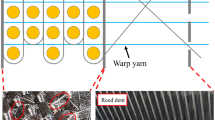Conclusions
It has been shown that in the continuous orientation stretching of Oksalon yarn in air, the deformation region is located close to the first stretch roll, including an arc of yarn slippage on it.
The need to take the slippage arc into account in continuous yarn stretching has been demonstrated.
By varying the frictional parameters of the first stretch roll, it is possible to achieve an increase in the strength of the finished yarn.
Similar content being viewed by others
Literature cited
S. P. Papkov, Physicochemical Bases of the Manufacture of Artificial Fibres [in Russian], Khimiya, Moscow (1972).
K. E. Perepelkin, Physicochemical Bases of Processes of Man-Made Fibre Spinning [in Russian], Khimiya, Moscow (1978).
N. P. Kruchinin, V. V. Romanov, et al., Khim. Volokna, No. 1, 15 (1983).
V. V. Romanov, N. P. Kruchinin, et al., Khim. Volokna, No. 1, 25 (1984).
A. V. Andreev, Transfer by Friction [in Russian], Mashinostroenie, Moscow (1978).
V. P. Napasnikov, Candidate's Dissertation, LITLP, Leningrad (1983).
Additional information
Translated from Khimicheskie Volokna, No. 5, pp. 22–23, September–October, 1985.
Rights and permissions
About this article
Cite this article
Romanov, V.V., Kruchinin, N.P., Kozhevnikov, Y.P. et al. Role of slippage in the orientation stretch of Oksalon yarns. Fibre Chem 17, 322–324 (1986). https://doi.org/10.1007/BF00544332
Received:
Issue Date:
DOI: https://doi.org/10.1007/BF00544332




